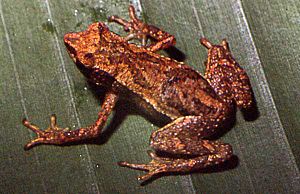Dendrophryniscus berthalutzae facts for kids
Quick facts for kids Dendrophryniscus berthalutzae |
|
|---|---|
 |
|
| Conservation status | |
| Scientific classification |
The Dendrophryniscus berthalutzae is a tiny species of toad. It belongs to the Bufonidae family, which includes many types of toads. This special toad is found only in southeastern Brazil. You can find it living in the coastal areas of Santa Catarina and Paraná states.
Why is it Called Berthalutzae?
This toad's specific name, berthalutzae, honors a remarkable person. It is named after Bertha Lutz. She was a very important scientist who studied reptiles and amphibians. Scientists who study these animals are called herpetologists. Bertha Lutz worked at the National Museum of Brazil. She was also a pioneer for women's rights.
What Does This Toad Look Like?
The Dendrophryniscus berthalutzae is a small toad. Adult males are usually about 18 to 21.5 millimeters long. That's less than an inch! Adult females are a bit bigger, measuring about 21.4 to 23.5 millimeters.
Its head is shaped like a triangle. This toad does not have a visible eardrum, which is called a tympanum. It has a clear ridge between its eye and snout, known as a canthus rostralis.
Its legs are thin, and its feet have only a little bit of webbing. The toad's back, or dorsum, feels bumpy. It has small, scattered bumps called tubercles. Its skin color helps it blend in with its surroundings. This is called cryptic coloration. You might notice an X-shaped mark on its shoulders. Its belly is plain and clean. The edges of its upper eyelids can be slightly or very noticeable.
Where Does This Toad Live and How is it Protected?
The Dendrophryniscus berthalutzae lives in humid rainforests. It can be found at different heights, from about 80 to 1100 meters above sea level. These toads like to hide among the fallen leaves on the forest floor.
They have a unique way of reproducing. The female toads lay their eggs in bromeliad plants. These plants collect water, creating small pools where the tadpoles can grow and develop.
Even though this toad is not very common, scientists still find it regularly. However, some toads that were once thought to be D. berthalutzae were later identified as a different species, Dendrophryniscus krausae, discovered in 2008. The biggest threat to this toad is habitat loss. This happens when forests are cut down, which is called deforestation. Protecting these rainforests is key to helping the Dendrophryniscus berthalutzae survive.


